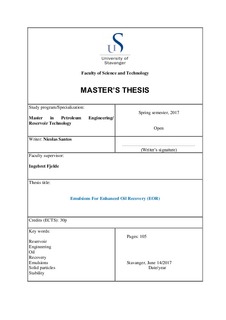| dc.description.abstract | ______Oil recovery projects have become a valuable source in oil industry in the recent years due to market challenges and economic stability. This is a typical practice that have been applied in oil and gas reservoirs to produce the volumes of oil that cannot be obtained by natural energy. Currently there are several methods that have proven to have pros and cons as being used as secondary or tertiary recovery technics. Within the most typical methods applied there are water flooding, chemical injection by the use of polymers and surfactants and thermal recovery methods.
______However, traditional technics have faced inconveniences that are exacerbated when producing heavy oil. On one hand waterflooding offers in most of the cases the lowest investment required but at the same time results have shown the lowest recovery value and sweep efficiency. In contrast chemical injection performs in the most effective way, with a stable displacement front and wettability changes that result in highest oil recovery values, but affecting economic budget with high investment that make companies think twice before its application. Additionally, considering the fact that heavy oil reservoirs represent most of the current worldwide reserves, thus high fluid viscosity shall be expected and consequently unfavorable mobility issues due to differences in fluids velocity through the porous media resulting in early water breakthrough.
______Hence, emulsion injection has come up as an attractive alternative to obtain higher oil recovery volumes compared to water flooding with a lower investment than the chemical injection. On one hand, when a stable emulsion is injected in the reservoir usually after a secondary recovery with waterflooding, it will tend to flow through the same high permeable water-wet zone previously covered by waterflooding if is an oil-in-water emulsion type (oil droplets dispersed in a continuous water phase). In this process oil droplets get trapped in the pore throats changing the wettability of the rock surface, decreasing the permeability of the invaded zone. As result water injected afterwards is forced to flow through less permeable zones that were not swept previously and the residual possible-to-mobilize oil that were trapped is displaced and produced, thus oil recovery increase.
______On the other hand emulsions are typically stabilized by the use of emulsifiers that are usually added in volumes (up to less than 1%wt) that lead to lower project investment compared to any chemical injection recovery project. However emulsion stabilized by solid particles are also an alternative technic that provides stabilization in oil-in-water and water-in-oil emulsions, but this alternative topic has a limited coverage in the literature. Therefore in this thesis three aspects of oil-in-water emulsions stabilized by clay solid particles were analyzed by experimental and mostly empirical studies that are intended to extent the knowledge in this topic.
______First, a better understanding of emulsion stability was addressed by a so-called flotation analysis, in which the behavior of the dispersed phase was assessed under different factors and scenarios. Results suggested that emulsion dispersion is affected by the quantities of the fluids and also by the continuous motion energy applied. Nonetheless stability is not compromised when steady conditions, but dispersed phase shows a flotation behavior that also changes according to dispersed phase and solid particles ratio.
______Secondly a procedure to determine the appropriate ratio of solid particles per volume of oil was prepared and tested to assure an efficient oil droplet protection by solid particles against coalescence that leads to dispersed phase separation. An simultaneously to reduce material waste that can lead to impact an oil recovery project by emulsion technique, thus an improved emulsion stability can be obtained without using more material than required.
______Finally a permeability reduction study was carried out by core flooding experiments to evaluate permeability changes in a porous media when the emulsion is injected. As a result, both a quantitative and qualitative results were obtained, showing a notorious permeability reduction affected by emulsion oil concentration up to 60% from the initial permeability, and also a remarkable emulsion stability was observed avoiding the droplets breaking, since during the emulsion flooding or by following water flooding no oil was produced at breakthrough. | nb_NO |

